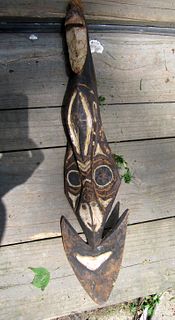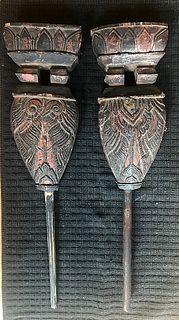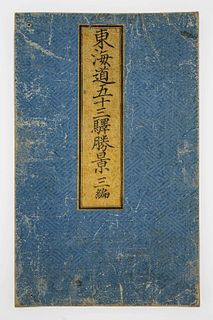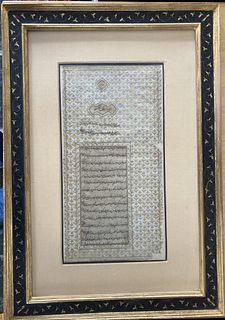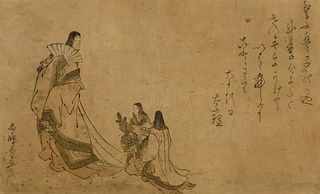Japanese Edo Shinto Mumei Kogatana Wakizashi w/ Saya
Lot 20a
About Seller
Artemis Fine Arts
686 S Taylor Ave, Ste 106
Louisville, CO 80027
United States
Selling antiquities, ancient and ethnographic art online since 1993, Artemis Gallery specializes in Classical Antiquities (Egyptian, Greek, Roman, Near Eastern), Asian, Pre-Columbian, African / Tribal / Oceanographic art. Our extensive inventory includes pottery, stone, metal, wood, glass and textil...Read more
Categories
Estimate:
$1,800 - $3,000
Absentee vs Live bid
Two ways to bid:
- Leave a max absentee bid and the platform will bid on your behalf up to your maximum bid during the live auction.
- Bid live during the auction and your bids will be submitted real-time to the auctioneer.
Bid Increments
| Price | Bid Increment |
|---|---|
| $1 | $25 |
About Auction
By Artemis Fine Arts
May 1, 2025
Set Reminder
2025-05-01 10:00:00
2025-05-01 10:00:00
America/New_York
Bidsquare
Bidsquare : Fine Antiquities, Asian, Ethno, Fine Art
https://www.bidsquare.com/auctions/artemis-gallery/fine-antiquities-asian-ethno-fine-art-19334
Showcasing an extraordinary array of artifacts and art, including Egyptian, Greek, Roman, Etruscan, Near Eastern, Asian, Pre-Columbian, Native American, Tribal, Oceanic, Spanish Colonial treasures, fossils, fine and visual arts, and more! All ancient items are ethically sourced and legally available for sale. Enjoy the ease of in-house shipping for a seamless experience! Artemis Fine Arts info@artemisfinearts.com
Showcasing an extraordinary array of artifacts and art, including Egyptian, Greek, Roman, Etruscan, Near Eastern, Asian, Pre-Columbian, Native American, Tribal, Oceanic, Spanish Colonial treasures, fossils, fine and visual arts, and more! All ancient items are ethically sourced and legally available for sale. Enjoy the ease of in-house shipping for a seamless experience! Artemis Fine Arts info@artemisfinearts.com
- Lot Description
East Asia, Japan, Edo period, Shinto era, ca. 1650 to 1800 CE. A testament to Edo-period artistry, this fine wakizashi and its saya present a harmonious blend of form and function. The long, unsigned blade of polished steel exhibits a subtle sori, a well-defined kissaki, and a mesmerizing wavy temper line born from the tightly folded itame-hada. The blade is embraced by a copper habaki, delicately sheathed in high-quality silver leaf. Above, the intricate openwork of the carbon steel tsuba captures the eye with a dynamic portrayal of two dragons sharing a wish pearl, enveloped by gilt copper seppa and a copper fuchi below. The tsuka provides a secure grip with its samegawa foundation, wrapped in precise cotton tsuka-ito and adorned with a pair of gilt copper menuki and a matching kashira. The lacquered urushi saya, painted in a lustrous green over black, not only protects the blade but also houses a steel kogatana. Its handle is graced with a gold-painted relief of two dragons, echoing the tsuba's motif. Size: 30" L x 2.75" W (76.2 cm x 7 cm)
For ease of carry, a cloth sageo is attached to a silver kurigata on the saya.
This traditional Japanese sword was both a weapon and a symbol of authority and social status. The wakizashi paired with the longer katana sword marked the wearer as a samurai. The shorter sword was seen as an auxiliary weapon, also used for fighting in close quarters. Wakizashi could also be worn by non-samurai if worn alone, and members of the merchant class (chonin) wore them because of the frequency of encountering bandits when traveling between Japan's cities.
Over the centuries that katana and wakizashi were made, the process of their manufacture became heavily regulated. For example, in 1683, the Tokugawa Shogunate made laws concerning the maximum size of katana and wakizashi. Meanwhile, once a samurai took ownership of his new weapon, he had to wear it in a highly regulated manner. Wakizashi and katana in this period were both deadly weapons and signs of prestige. The craftsmanship of this piece is evident and reflects hundreds of hours of work.
Provenance: private Burke, Virginia, USA collection
All items legal to buy/sell under U.S. Statute covering cultural patrimony Code 2600, CHAPTER 14, and are guaranteed to be as described or your money back.
A Certificate of Authenticity will accompany all winning bids.
We ship worldwide and handle all shipping in-house for your convenience.
SHIPPING EXCEPTIONS: Due to customs clearance issues, we are unable to ship to Germany, Switzerland and Australia. If you live in Germany, Switzerland or Australia, you will need to provide an alternate shipping destination, or we will not be able to complete your purchase. In addition, please note that we are unable to ship ancient items back to the original country of origin (Egyptian to Egypt, Greek to Greece, etc.)
PAYMENT EXCEPTION: Unless a known customer of Artemis, payment for all gold / precious metal / gem lots must be made via Bank Wire Transfer or Certified Bank Check/Money Order, no exceptions.
SHIPPING EXCEPTIONS: Due to customs clearance issues, we are unable to ship to Germany, Switzerland and Australia. If you live in Germany, Switzerland or Australia, you will need to provide an alternate shipping destination, or we will not be able to complete your purchase. In addition, please note that we are unable to ship ancient items back to the original country of origin (Egyptian to Egypt, Greek to Greece, etc.)
PAYMENT EXCEPTION: Unless a known customer of Artemis, payment for all gold / precious metal / gem lots must be made via Bank Wire Transfer or Certified Bank Check/Money Order, no exceptions.
#192553Light wear with patina to tsuba and some loss to gold-paint on handle of kogatana. Otherwise, intact and excellent with a striking presentation. Accompanied by protective, cloth carrying bag.Condition
- Shipping Info
-
All shipping is handled in-house for your convenience. Your invoice from Artemis Gallery will include shipping calculation instructions. If in doubt, please inquire BEFORE bidding for estimated shipping costs for individual items.
-
- Buyer's Premium



 EUR
EUR CAD
CAD AUD
AUD GBP
GBP MXN
MXN HKD
HKD CNY
CNY MYR
MYR SEK
SEK SGD
SGD CHF
CHF THB
THB









